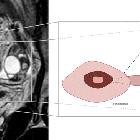salpingitis isthmica nodosa


Salpingitis isthmica nodosa (SIN), sometimes also referred to as perisalpingitis isthmica nodosa or diverticulosis of the Fallopian tube, refers to nodular scarring of the Fallopian tubes. In very early stages, the tubes may appear almost normal. As scarring and nodularity progress, the changes become more radiographically apparent.
Pathology
Salpingitis isthmica nodosa, as the name implies, is irregular benign extensions of the tubal epithelium into the myosalpinx mainly at the isthmic/proximal portion. It is associated with reactive hypertrophy and sometimes inflammation. On histopathology nodular thickening of the muscularis layer of the Fallopian tube with outpouchings of the overgrown epithelium into the tubal wall can be seen, forming inclusion cysts or diverticula .
Etiology
- the etiology of SIN has remained a matter of controversy since its first description
- the prevailing theories include an inflammatory (salpingitis), a congenital, and more recently an acquired (but not post-inflammatory) etiology
Location
It can involve the entire Fallopian tube, but more often involves the isthmic segment of the Fallopian tube. Bilateral in ~85% of patients .
Radiographic features
An accurate radiographic diagnosis is important due to its high association with infertility and ectopic pregnancy.
Hysterosalpingography (HSG)
A characteristic finding is multiple nodular diverticular spaces involving the Fallopian tubes, usually involving the proximal two-thirds of the Fallopian tubes.
HSG of the nodular area with severe SIN shows several pockets (diverticula) containing the introduced contrast material .
It is observed that no dominant channel is seen as the contrast flows through the tube. This means there appears to be no direct pathway for sperm to travel which increases the chances of a tubal pregnancy.
Treatment and prognosis
Treatment can be considered with recanalization procedures either using a catheter guided by interventional radiology or by endoscopic surgery.
Complications:
- increased risk of tubal ectopic pregnancy
- subfertility
History and etymology
The term is derived from salpingitis for inflammation of the salpinx (tube), isthmica for the involvement of the proximal isthmic portion of Fallopian tube and nodosa for its nodular appearance. It was first described on histopathology in 1887.
Differential diagnosis
Considerations include:
- tubal tuberculosis
- often multiple constrictions can form along the course of the Fallopian tube due to scarring, and give rise to a "beaded" appearance of the tubes on HSG
- can also have adnexal calcification
- endometriosis
- tubal adenomyosis
Siehe auch:
und weiter:

 Assoziationen und Differentialdiagnosen zu salpingitis isthmica nodosa:
Assoziationen und Differentialdiagnosen zu salpingitis isthmica nodosa:

